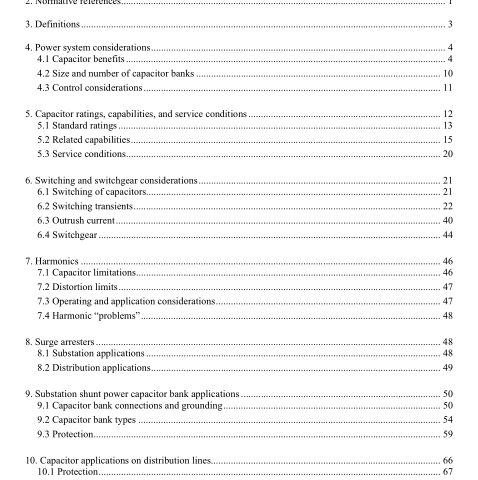IEEE 1036-2010 pdf download.IEEE Guide for Application of Shunt Power Capacitors
IEEE 1036-2010 pdf downloadThis guide applies to the use of 50 Hz and 60 Hz shunt power capacitors rated 2400 Vac and above, and assemblies of such capacitors. Included are guidelines for the application, protection, and ratings of equipment for the improved safety and reliability in the utilization of shunt power capacitors. The guide is general and intended to be basic and supplemental to specific recommendations of the manufacturer. The guide covers applications that range from simple capacitor unit utilization to complex capacitor bank situations.
2. Normative references
The following referenced documents are indispensable for the application of this document (i.e., they must be understood and used, so each referenced document is cited in text and its relationship to this document is explained). For dated references, only the edition cited applies. For undated references, the latest edition of the referenced document (including any amendments or corrigenda) applies.
ANSI C2-2007, National Electrical Safety Code, American National Standards Institute. 1
ANSI C37.06-2009, American National Standard for AC High-Voltage Circuit Breakers Rated on a
Symmetrical Current Basis—Preferred Ratings and Related Required Capabilities. 2
ANSI C37.66-2005, American National Standard Requirements for Oil-Filled Capacitor Switches for
Alternating-Current Systems.
IEEE Std 18™-2002, IEEE Standard for Shunt Power Capacitors.
IEEE Std C37.04™-1999, IEEE Standard Rating Structure for AC High-Voltage Circuit Breakers.
IEEE Std C37.012™-2005, IEEE Application Guide for Capacitance Current Switching for AC HighVoltage Circuit Breakers Rated on a Symmetrical Current Basis.
IEEE Std C37.48™-2005, IEEE Guide for Application, Operation, and Maintenance of High-Voltage Fuses, Distribution Enclosed Single-Pole Air Switches, Fuse Disconnecting Switches, and Accessories.
IEEE Std C37.99-2000, IEEE Guide for Protection of Shunt Capacitor Banks.
IEEE Std C62.2-1987, IEEE Guide for the Application of Gapped Silicon-Carbide Surge Arresters for Alternating-Current Systems.
IEEE Std C62.22™-2009, IEEE Guide for the Application of Metal Oxide Surge Arresters for Alternating-Current Systems.
IEEE Std 141™-1993 (Reaff 1999), IEEE Recommended Practice for Electric Power Distribution for Industrial Plants (IEEE Red Book™).
IEEE Std 262B-1977, IEEE Trial-Use Standard Dielectric Test Requirements for Power Transformers for Operation on Effectively Grounded Systems 345 kV and Above (Trial-Use Supplement to IEEE Std 262-1973, ANSI C57.12.90-1973). 5
IEEE Std 519-2004, IEEE Recommended Practices and Requirements for Harmonic Control in Electric Power Systems.
IEEE Std 1247™-2005, IEEE Standard for Interrupter Switches for Alternating Current, Rated Above 1,000 Volts.
IEEE Std 1531™-2003, IEEE Guide for Application and Specification of Harmonic Filters.
NFPA 70-2008, National Electrical Code ® (NEC ® )
3. Definitions
For the purposes of this document, the following terms and definitions apply. The IEEE Standards Dictionary: Glossary of Terms & Definitions should be referenced for terms not defined in this clause.
3.1 ambient temperature: The temperature of the medium, such as air, water, or earth, into which the heat of the equipment is dissipated.
NOTE 1—For self-ventilated equipment, the ambient temperature is the average temperature of the air in the immediate vicinity of the equipment.
NOTE 2—For air- or gas-cooled equipment with forced ventilation or secondary water cooling, the ambient temperature is taken as that of the ingoing air or cooling gas.
NOTE 3—For self-ventilated enclosed (including oil-immersed) equipment considered as a complete unit, the ambient temperature is the average temperature of the air outside of the enclosure in the immediate vicinity of the equipment. See 5.7 and Table 1 of IEEE Std 18-2002.
3.2 back-to-back capacitor bank switching (back-to-back switching, back-to-back capacitor switching): Switching a capacitor bank in close enough electrical proximity to one or more other energized capacitor banks and/or cables to significantly influence the inrush current.
3.3 capacitor bank: An assembly at one location of capacitor(s) and all necessary accessories, such as switching equipment, protective equipment, controls, et cetera, required for a complete operating installation. It may be a collection of components assembled at the operating site or may include one or more pieces of factory-assembled equipment.
3.4 capacitor control: The device required to automatically operate the switching device(s) to energize and de-energize shunt power capacitor banks.
3.5 capacitor element: The basic component of a capacitor unit consisting of two electrodes separated by a dielectric.
3.6 capacitor equipment: A complete assembly of capacitors, including accessories such as buses, connectors, dischargers, and fuses suitable for connection to a power system.
3.7 capacitor line fuse (capacitor group fuse): A fuse applied to disconnect a faulted phase of a capacitor bank from the power system.
3.8 externally fused capacitor bank: A capacitor equipment with fuses external to the (power) capacitor units.
3.9 filter capacitor: Capacitor(s) utilized with inductors and/or resistors for controlling harmonic voltages and currents in the power system.
3.10 fixed capacitor bank: A capacitor bank not designed for automatic operation or frequent switching.IEEE 1036 pdf download.IEEE 1036-2010 pdf download
IEEE 1036-2010 pdf download

Leave a Reply